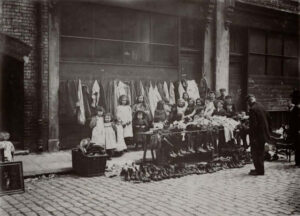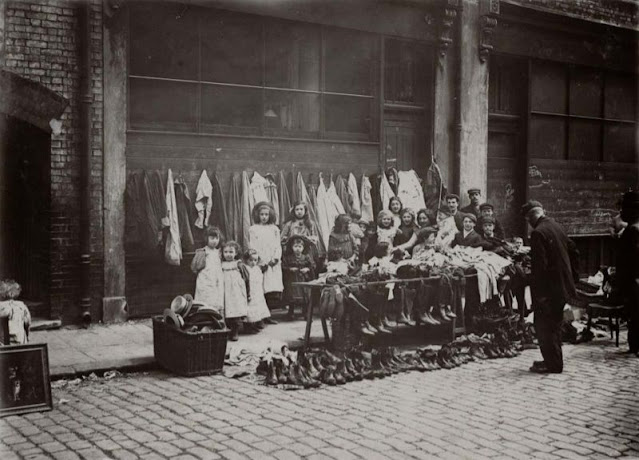
In 1902, the American author Jack London visited his namesake city where he took pictures of its people and their everyday life. In the book The People of the Abyss, London described this first-hand account by living in the East End (including the Whitechapel District) for several months, sometimes staying in workhouses or sleeping on the streets.
Such conditions he experienced were the same as those endured by an estimated 500,000 of the contemporary London poor. “Some were drowsing standing up; half a score of them were stretched out on the stone steps in most painful postures… the skin of their bodies showing red through the holes, and rents in their rags.” He wrote.
To blend into the locals and get to know the conditions of their everyday life, London disguised himself as an American sailor who had lost his ship and went into the East End. Between 1900 and 1916 the American writer took more than 12 thousand photographs.

|
| Men queue for a ticketed Salvation Army breakfast. |
 |
| Bank Holiday, Whitechapel. |
 |
| Homeless people in Itchy Park, Spitalfields. |
 |
| An East End Slavey (a maidservant, especially a hard-worked one). |
 |
| Spitalfields at the junction of Commercial Street and Brushfield Street. |

|
| View in Hoxton. |

|
| A policeman shines a flashlight onto a young man sleeping on the sidewalk against a building. |

|
| “No. 1 Victoria Home for Working Men.” |
 |
| A street in Wapping. |
 |
| Wide view along Whitechapel Infirmary. |
 |
| A typical East End home where the people eat, live, and sleep eat all in one room. |
 |
| Drunken women fighting on a rooftop. |
 |
| “Tottery old men and women were searching in the garbage thrown in the mud.” |
 |
| View in Stratford. |
 |
| Casual ward of Whitechapel Workhouse above, beds rolled up on left and right. |
 |
| “Gigantic dosshouse” Rowton House, Fieldgate Street, Whitechapel. |
 |
| Homeless people sleeping under the arches of Tower Bridge. |
 |
| Mile End Road showing the People’s Palace. |
 |
| A street shop where old clothes are sold. |
 |
| “In the shadow of Christ Church, Spitalfields, I saw a sight…” |
 |
| Men working in casual ward of workhouse picking oakum. |
 |
| Homeless women, Spitalfields Garden. |
 |
| An alley on London’s East End. |
 |
| Frying Pan Alley (close to Middlesex Street and Petticoat Lane market), Spitalfields. |
 |
| Men spending the night outdoors huddle together for warmth. |
 |
| “Two relay system lodging, lodgers who have been on night work waiting till the beds of a doss house are vacated by men employed during the way.” |
 |
| Men sleeping in Green Park. |

|
| Men queue for a ticketed Salvation Army breakfast. |
